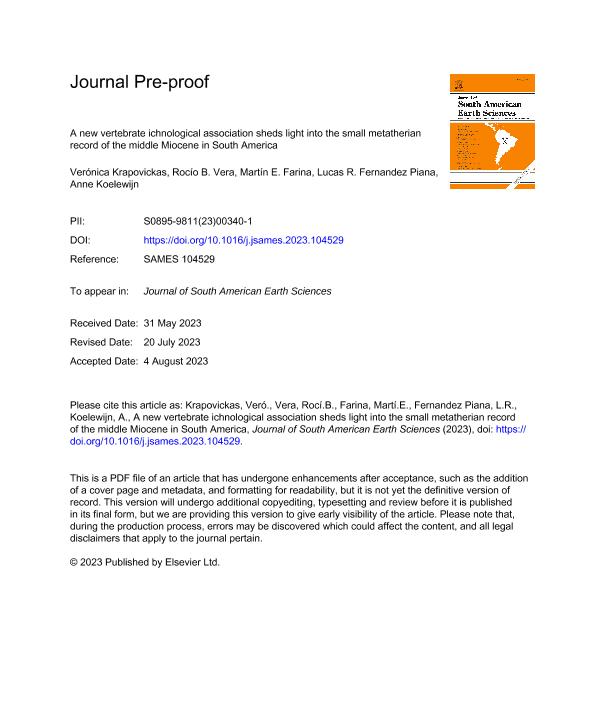Artículo
A new vertebrate ichnological association sheds light on the small metatherian record of the Middle Miocene in South America
Krapovickas, Verónica ; Vera, Rocío Belén
; Vera, Rocío Belén ; Farina, Martin Ezequiel; Fernandez Piana, Lucas Raul
; Farina, Martin Ezequiel; Fernandez Piana, Lucas Raul ; Koelewijn, Anne
; Koelewijn, Anne
 ; Vera, Rocío Belén
; Vera, Rocío Belén ; Farina, Martin Ezequiel; Fernandez Piana, Lucas Raul
; Farina, Martin Ezequiel; Fernandez Piana, Lucas Raul ; Koelewijn, Anne
; Koelewijn, Anne
Fecha de publicación:
09/2023
Editorial:
Pergamon-Elsevier Science Ltd
Revista:
Journal of South American Earth Sciences
ISSN:
0895-9811
Idioma:
Inglés
Tipo de recurso:
Artículo publicado
Clasificación temática:
Resumen
Vertebrate ichnological associations recorded in Middle Miocene successions were unknown in South America. During that time, South America was isolated from other continents and had a unique endemic fauna and flora. The lower Vinchina succession occurred between 15.6 and 12.7 Ma and records the footprints of highly specialized mammals, reptiles, and birds for the first time. To identify all footprint producers, we focused on anatomical traits of the appendicular skeleton represented on the footprints together with body size estimations of the producers as body mass and the apparent trunk length (GAD). Carnivoripeda sudamericana nov. isp. reveals a weasel-like producer of ∼1 kg and a trunk length of 19–26 cm most likely attributed to metatherian carnivores (Sparassodonta). They represent the oldest carnivore footprints in South America. Small bipedal rodent-like mammals of ∼280 g using a jumping gait (Morphotype A) are interpreted as produced by highly specialized South American marsupials, argyrolagids, whose footprints were unknown until now. Other mammalian footprints recorded are Tacheria troyana most likely produced by dinomyid caviomorph rodents. They represent animals of ∼16 kg and a trunk length of 48–55 cm, like living dinomyids. Subcircular to oval structures (Morphotype B) seems to be produced by medium-sized ungulates, while stepping in cohesive and plastic soupy sediments. cf. Chelonipus torquatus suggests small freshwater turtles (Chelidae or Podocnemididae), of ∼400 g consistent with a trackmaker of carapace size of ∼9 cm. Aviadactyla vialovi was most likely produced by a small shorebird (Scopolacidae) of ∼40 g. All footprints are preserved on crevasse splay deposits of anastomosing fluvial systems together with meniscate feeding (Taenidium barretti) and simple dwelling trace fossils (Palaeophycus tubularis) produced by insects and are an example of the Scoyenia Ichnofacies.
Palabras clave:
ARGYLOLAGIDAE
,
CHELIDAE
,
DINOMYDAE
,
PODOCNEMIDIDAE
,
SHOREBIRDS
,
SPARASSODONTA
Archivos asociados
Licencia
Identificadores
Colecciones
Articulos(IDEAN)
Articulos de INSTITUTO DE ESTUDIOS ANDINOS "DON PABLO GROEBER"
Articulos de INSTITUTO DE ESTUDIOS ANDINOS "DON PABLO GROEBER"
Citación
Krapovickas, Verónica; Vera, Rocío Belén; Farina, Martin Ezequiel; Fernandez Piana, Lucas Raul; Koelewijn, Anne; A new vertebrate ichnological association sheds light on the small metatherian record of the Middle Miocene in South America; Pergamon-Elsevier Science Ltd; Journal of South American Earth Sciences; 129; 9-2023; 1-75
Compartir
Altmétricas



